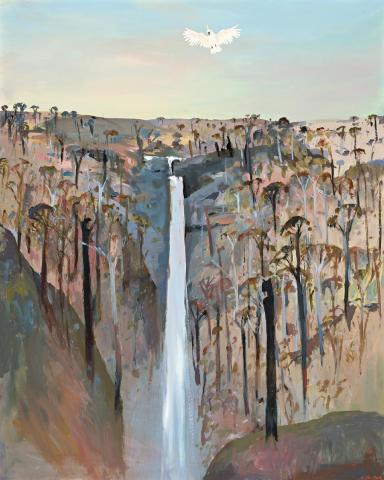WATERFALL ON THE BANKS OF THE SHOALHAVEN RIVER
ARTHUR BOYD
oil on composition board
152.5 x 122.0 cm
signed lower right: Arthur Boyd
Art Galleries Schubert, Queensland
Private collection, Melbourne
Waterfall and Rockface at Shoalhaven Valley, 1975, watercolour and gouache on paper, illus. in McGrath, S., The Artist and The River: Arthur Boyd and the Shoalhaven, Bay Books, Sydney, 1982, p. 203
Eager to rediscover his roots, his 'Australianism', after more than a decade abroad, in 1971 Arthur Boyd settled on the banks of the Shoalhaven River where once again the magic of the dour, untamed Australian landscape became the impetus for his art. Wild and primordial, the region differed completely from the ordered English countryside to which he had grown accustomed and thus, a new vision was required to unlock its tangled mysteries. If previously Breughel and Rembrandt had offered inspiration, now Von Guerard, Piguenit and Buvelot became Boyd's spiritual mentors; as he mused, 'I see the landscape looking very much like a Von Guerard, much more than the look of the Australian Impressionist school. In this area you are aware again and again how those old boys got it right all the time.'1
Soul-piercing in its beauty, the Shoalhaven region offered infinite potential as a subject - 'the variation in the area with its great deep tones and high keys' bearing strong affinities with music. As Boyd elaborated, '... in the desert there is only one note, just one low singing note. In this landscape the tonal range -not tonal in the obvious sense of colour, but the actual fact of the horizon which can vary from very high to low to infinite, depending on your line of vision - makes it a greater challenge. It has a knife-edged clarity. Impressionism could never have been born here, but Wagner could easily have composed here.2
Suffused with warmth and lyricism, Waterfall on the Banks of the Shoalhaven River is an exquisitely painted example of the 'pure' Shoalhaven landscapes which, devoid of the mythological creatures and symbolic narrative punctuating his earlier versions (see for example lot XXX), celebrate Nature in all her beauty and grandeur. Indeed, the work is a poignant reminder of how Boyd, comfortable once more with the eternal diversity of the Australian landscape, ultimately did tame his wilderness - '... what was unfamiliar became familiar, what was menacing became friendly, what was awesome became intimate.'3
1. Boyd cited in McGrath, S., The Artist and the Shoalhaven, Bay Books, Sydney, 1982, p. 220
2. Boyd cited in Pearce, B., Arthur Boyd Retrospective, Art Gallery of New South Wales, Sydney, 1993, pp. 26-27
3. McGrath, op.cit., p. 79
VERONICA ANGELATOS
